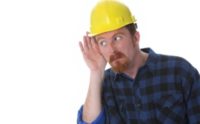 Source: www.NIOSH.gov
Source: www.NIOSH.gov
Noise-induced hearing loss is the most common work-related illness in the United States. Each year, an estimated 22 million U.S. workers encounter noise exposures loud enough to be potentially hazardous. In addition to damaging workers' quality of life, occupational hearing loss can carry a high economic price to society.
What are the Risk Factors?
Occupational hearing loss occurs as a result of workers' exposure to loud noise. In fact, the National Institute for Occupational Safety and Health (NIOSH) recommends that workers should not be exposed to noise at a level that amounts to more than 85 decibels (dBA) for 8 hours. The level of risk is influenced by several factors:
- Noise level – as noise level increases, the risk also increases
- Duration of exposure – the longer the noise lasts, the more hazardous it becomes
- Impulsiveness – noises that have very abrupt starts and stops (such as hammering, gunfire, or fireworks) are more dangerous than constant noise of the same overall level
- Intermittency – periods of relative quiet between exposures allow the ear to "rest" and reduce the risk
Learn more about Noise and Hearing Loss Prevention.
Ototoxic chemicals can also affect hearing. Workplace chemicals that pose a threat to hearing include:
- Organic solvents – e.g., toluene, styrene, xylene, ethylbenzene, trichloroethylene
- Heavy metals – e.g., mercury, lead, trimethyltin
- Asphyxiants – e.g., carbon monoxide, hydrogen cyanide
- Endocrine disrupters – e.g., Aroclor 1254, Acrylonitrile
All workers are not equally vulnerable to occupational hearing loss. Certain biological factors such as gender, age, race/ethnicity, genetics, and health issues can influence a worker's susceptibility to the effects of noise.
The ear does not experience pain in the same way the rest of the body does. If your ears feel stuffy or full your ears are telling you that you have potentially harmed them. Ringing or roaring in your ears indicate a serious noise exposure, which if continued could lead to permanent damage and hearing loss.
Develop a Hearing Loss Prevention Program
In order to minimize occupational risks and reduce work-related hearing loss, companies and organizations should consider implementing a Hearing Loss Prevention Program. Critical components to any Hearing Loss Prevention Program include:
- Noise exposure monitoring
- Engineering and administrative controls
- Audiometric evaluation
- Hearing protection devices
- Education and motivation
- Record keeping
- Program evaluation
To create a more healthful workplace, the NIOSH recommends preventing hazardous noise through controls for noise exposure and encourages employers to create Buy Quiet programs as a first step. Learn more about Buy Quiet by visiting our website.
Hearing protection: a practical step
Although removal or control of hazardous noise from the workplace is the best solution, hearing protectors should be used in situations where dangerous noise exposures have not yet been eliminated. NIOSH has developed tools that provide valuable information about hearing protection devices.
Hearing Protector Device Compendium is a comprehensive searchable database of hearing protection devices. This web tool was created to help workers and safety professionals select the most appropriate product for their unique environment. The tool identifies hearing protector devices by type, manufacturer, and noise exposure level.
NIOSH HPD Well-Fit™ can quickly and inexpensively test the performance of hearing protection. This fit-testing technology is a significant advancement in efforts to preserve workers' hearing. HPD Well-FitTM utilizes technology that is built into just about every computer sold today, requires only 4-7 minutes to measure HPD performance, and can be used with any earplug.






